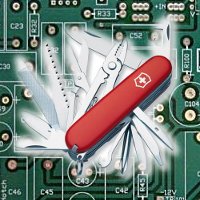Tiny Device
 Tiny CPU just barely squeezes into a 128-macrocell CPLD, and so I’ve designed a companion chip called Tiny Device to handle other interface functions. It utilizes a second CPLD, and was originally envisioned as a simple address decoder, but its functions have grown and grown again. The second CPLD is now completely filled as well, and Tiny Device has turned into the Swiss Army Knife of this computer system. Here’s a list of its capabilities:
Tiny CPU just barely squeezes into a 128-macrocell CPLD, and so I’ve designed a companion chip called Tiny Device to handle other interface functions. It utilizes a second CPLD, and was originally envisioned as a simple address decoder, but its functions have grown and grown again. The second CPLD is now completely filled as well, and Tiny Device has turned into the Swiss Army Knife of this computer system. Here’s a list of its capabilities:
Address Decoding
As I described in yesterday’s posting, the Tiny Computer memory map is more complex than just statically-mapped RAM and ROM ranges. Tiny Device employs bank switching to dynamically map one of 128 physical memory banks into the lower half of the CPU’s address space. It also manages eight I/O ports in the upper half of the address space, for controlling the bank switching and interfacing with other hardware.
Keyboard Inteface
A PS/2 keyboard interface is provided, using a variation of the design I built from discrete logic for BMOW 1. Incoming keyboard bits are shifted in to a register, and when a complete byte has been read, Tiny Device sets a status bit to inform the CPU. There is no buffering, so if the CPU doesn’t read the byte before the next one arrives (approximately 3 ms), data will be lost.
Serial Input
Using a super-sampling technique, Tiny Device provides a virtual 57,600 bps serial port. Similar to the keyboard, incoming bits are shifted into a register, and a status bit signals the CPU when a byte is ready. A one byte buffer is provided, so the CPU must read the byte before the final bit of the next byte arrives (173 us at 56K bps), or data will be lost.
Serial Output
A separate serial output circuit operates independently of input, providing for simultaneous two-way communication. A status bit informs the CPU when the output circuit is idle and ready to accept a new byte. The CPU must not send a new byte while the output circuit is still busy with the previous one.
LCD Interface
Tiny Device provides a basic interface for communicating with a 128 x 64 graphical LCD. Each of the LCD data and control lines is mapped to an I/O port, but no other control logic is implemented. The CPU is responsible for manipulating the lines as needed to communicate with the LCD, and observing its slow timing requirements.
Tick Count
An 8-bit tick counter is provided at one of the I/O ports. It increments every 3.2 us, and can be used for timing-sensitive loops used to generate audio, measuring the period of time between events, or seeding a random number generator.
Clock Division
To provide timing flexibility, a 20 MHz oscillator is divided by four to create the 5 MHz system clock. This allows the system clock speed to be increased or decreased later, without needing to replace the oscillator.
Output Port
A generic 8-bit output port provides direct control over two LEDs and a piezo speaker.
Status Flags
Tiny CPU queries the status register to get the current state of all I/O devices. This includes the ready flags for the keyboard, serial in, and serial out, as well as the current position of the up/down/set navigation switch.
All of this fits in 127 of the CPLD’s 128 macrocells, making Tiny Device an even tighter fit than Tiny CPU. The Tiny Device Verilog source can be viewed here.
Read 4 comments and join the conversation4 Comments so far
Leave a reply. For customer support issues, please use the Customer Support link instead of writing comments.


great project, I am just starting out on TTL project, thinking to do fpga / cpld second (for me I wanted to be bigger in second project, bigger buses, VM etc)
Q: what software did you use for cpld design and simulation?
Q: for PALs in your first project – how did you program them?
PS – v impressed with board, nice layout and neatly soldered
Very impressed. Keep it up.
The CPLD design and simulation has been done using Altera’s free version of Quartus II. For the PALs used in BMOW, the logic equations were compiled using EQN2JED, and then the PALs were programmed using a regular EPROM programmer.